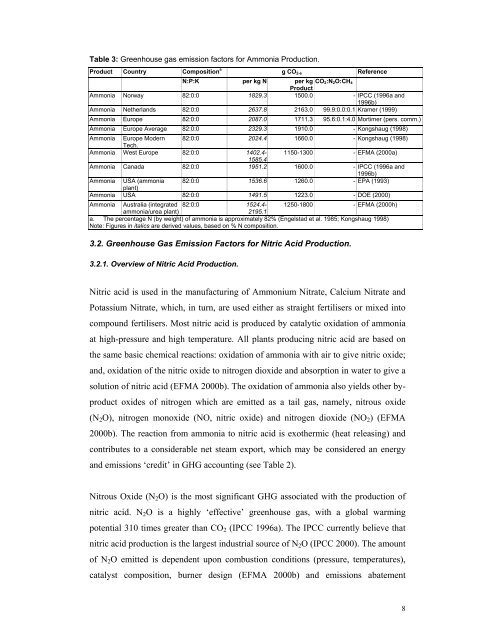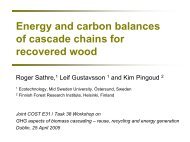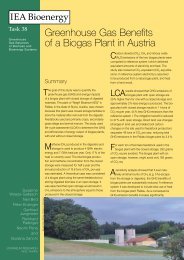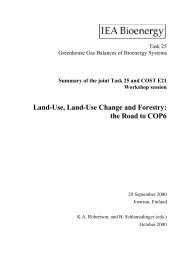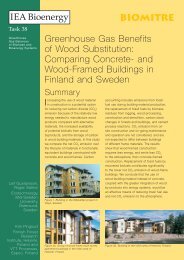A review of greenhouse gas emission factors for fertiliser production.
A review of greenhouse gas emission factors for fertiliser production.
A review of greenhouse gas emission factors for fertiliser production.
Create successful ePaper yourself
Turn your PDF publications into a flip-book with our unique Google optimized e-Paper software.
Table 3: Greenhouse <strong>gas</strong> <strong>emission</strong> <strong>factors</strong> <strong>for</strong> Ammonia Production.Product Country Composition a g CO 2-e ReferenceN:P:K per kg N per kg CO 2:N 2O:CH 4ProductAmmonia Norway 82:0:0 1829.3 1500.0 - IPCC (1996a and1996b)Ammonia Netherlands 82:0:0 2637.8 2163.0 99.9:0.0:0.1 Kramer (1999)Ammonia Europe 82:0:0 2087.0 1711.3 95.6:0.1:4.0 Mortimer (pers. comm.)Ammonia Europe Average 82:0:0 2329.3 1910.0 - Kongshaug (1998)Ammonia Europe Modern 82:0:0 2024.4 1660.0 - Kongshaug (1998)Tech.Ammonia West Europe 82:0:0 1402.4- 1150-1300 - EFMA (2000a)1585.4Ammonia Canada 82:0:0 1951.2 1600.0 - IPCC (1996a and1996b)Ammonia USA (ammonia 82:0:0 1536.6 1260.0 - EPA (1993)plant)Ammonia USA 82:0:0 1491.5 1223.0 - DOE (2000)Ammonia Australia (integrated 82:0:0 1524.4- 1250-1800 - EFMA (2000h)ammonia/urea plant)2195.1a. The percentage N (by weight) <strong>of</strong> ammonia is approximately 82% (Engelstad et al. 1985; Kongshaug 1998)Note: Figures in italics are derived values, based on % N composition.3.2. Greenhouse Gas Emission Factors <strong>for</strong> Nitric Acid Production.3.2.1. Overview <strong>of</strong> Nitric Acid Production.Nitric acid is used in the manufacturing <strong>of</strong> Ammonium Nitrate, Calcium Nitrate andPotassium Nitrate, which, in turn, are used either as straight <strong>fertiliser</strong>s or mixed intocompound <strong>fertiliser</strong>s. Most nitric acid is produced by catalytic oxidation <strong>of</strong> ammoniaat high-pressure and high temperature. All plants producing nitric acid are based onthe same basic chemical reactions: oxidation <strong>of</strong> ammonia with air to give nitric oxide;and, oxidation <strong>of</strong> the nitric oxide to nitrogen dioxide and absorption in water to give asolution <strong>of</strong> nitric acid (EFMA 2000b). The oxidation <strong>of</strong> ammonia also yields other byproductoxides <strong>of</strong> nitrogen which are emitted as a tail <strong>gas</strong>, namely, nitrous oxide(N 2 O), nitrogen monoxide (NO, nitric oxide) and nitrogen dioxide (NO 2 ) (EFMA2000b). The reaction from ammonia to nitric acid is exothermic (heat releasing) andcontributes to a considerable net steam export, which may be considered an energyand <strong>emission</strong>s ‘credit’ in GHG accounting (see Table 2).Nitrous Oxide (N 2 O) is the most significant GHG associated with the <strong>production</strong> <strong>of</strong>nitric acid. N 2 O is a highly ‘effective’ <strong>greenhouse</strong> <strong>gas</strong>, with a global warmingpotential 310 times greater than CO 2 (IPCC 1996a). The IPCC currently believe thatnitric acid <strong>production</strong> is the largest industrial source <strong>of</strong> N 2 O (IPCC 2000). The amount<strong>of</strong> N 2 O emitted is dependent upon combustion conditions (pressure, temperatures),catalyst composition, burner design (EFMA 2000b) and <strong>emission</strong>s abatement8


